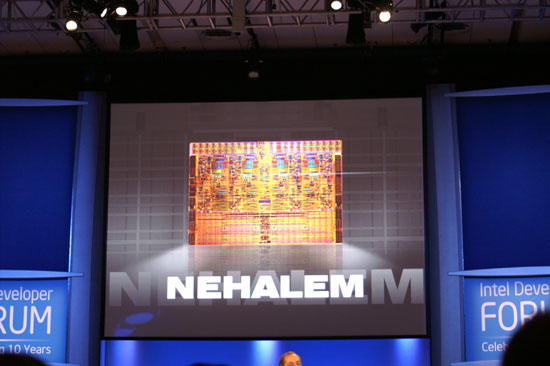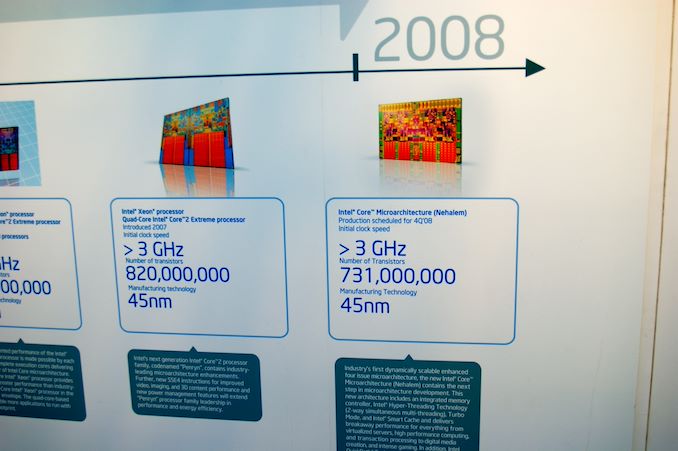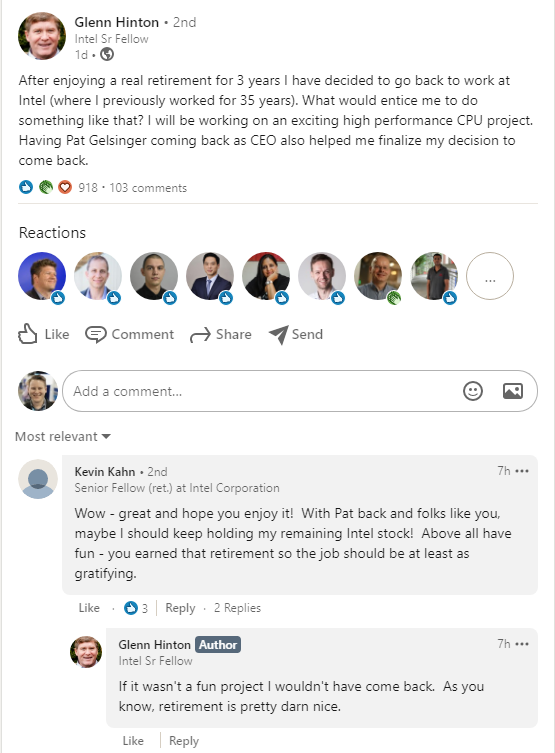New Intel CEO Making Waves: Rehiring Retired CPU Architects
by Dr. Ian Cutress on January 21, 2021 5:05 AM EST- Posted in
- CPUs
- Intel
- Nehalem
- Pat Gelsinger

We’re following the state of play with Intel’s new CEO, Pat Gelsinger, very closely. Even as an Intel employee for 30 years, rising to the rank of CTO, then taking 12 years away from the company, his arrival has been met with praise across the spectrum given his background and previous successes. He isn’t even set to take his new role until February 15th, however his return is already causing a stir with Intel’s current R&D teams.
News in the last 24 hours, based on public statements, states that former Intel Senior Fellow Glenn Hinton, who lists being the lead architect of Intel’s Nehalem CPU core in his list of achievements, is coming out of retirement to re-join the company. (The other lead architect of Nehalem are Ronak Singhal and Per Hammerlund - Ronak is still at Intel, working on next-gen processors, while Per has been at Apple for five years.)
Hinton is an old Intel hand, with 35 years of experience, leading microarchitecture development of Pentium 4, one of three senior architects of Intel’s P6 processor design (which led to Pentium Pro, P2, P3), and ultimately one of the drivers to Intel’s Core architecture which is still at the forefront of Intel’s portfolio today. He also a lead microarchitect for Intel’s i960 CA, the world’s first super-scalar microprocessor. Hinton holds more than 90+ patents from 8 CPU designs from his endeavors. Hinton spent another 10+ years at Intel after Nehalem, but Nehalem is listed in many places as his primary public achievement at Intel.
On his social media posts, Hinton states that he will be working on ‘an exciting high performance CPU project’. In the associated comments also states that ‘if it wasn’t a fun project I wouldn’t have come back – as you know, retirement is pretty darn nice’. Glenn also discloses that he has been pondering the move since November, and Gelsinger’s re-hiring helped finalize that decision. His peers also opine that Glenn is probably not the only ex-Intel architect that might be heading back to the company. We know a few architects and specialists that have left Intel in recent years to join Intel's competitors, such as AMD and Apple.
There are a few key things to note here worth considering.
First is that coming out of retirement for a big CPU project isn’t a trivial thing, especially for an Intel Senior Fellow. Given Intel’s successes, one would assume that the financial situation is not the main driver here, but the opportunity to work on something new and exciting. Plus, these sorts of projects take years of development, at least three, and thus Glenn is signing on for a long term despite already having left to retire.
Second point is reiterating that last line – whatever project Glenn is working on, it will be a long term project. Assuming that Glenn is talking about a fresh project within Intel’s R&D ecosystem, it will be 3-5 years before we see the fruits of the labor, which also means creating a design aimed at what could be a variety of process node technologies. Glenn’s expertise as lead architect is quite likely applicable for any stage of an Intel R&D design window, but is perhaps best served from the initial stages. The way Glenn seems to put it, this might be a black-ops style design. It also doesn't specify if this is x86, leaving that door open to speculation.
Third here is to recognize that Intel has a number of processor design teams in-house and despite the manufacturing process delays, they haven’t been idle. We’ve been seeing refresh after refresh of Skylake lead Intel's portfolio, and while the first iterations of the 10nm Cove cores come to market, Intel’s internal design teams would have been working on the next generation, and the next generation after that – the only barrier to deployment would have been manufacturing. I recall a discussion with Intel’s engineers around Kaby Lake time, when I asked about Intel’s progress on IPC – I requested a +10% gen-on-gen increase over the next two years at the time, and I was told that those designs were done and baked – they were already working on the ones beyond that. Those designs were likely Ice/Tiger Lake, and so Intel’s core design teams have been surging ahead despite manufacturing issues, and I wonder if there’s now a 3-4 year (or more) delay on some of these designs. If Glenn is hinting at a project beyond that, then we could be waiting even longer.
Fourth and finally, one of the critical elements listed by a number of analysts on the announcement of Gelsinger’s arrival was that he wouldn’t have much of an effect until 3+ years down the line, because of how product cycles work. I rejected that premise outright, stating that Pat can come in and change elements of Intel’s culture immediately, and could sit in the room with the relevant engineers and discuss product design on a level that Bob Swan cannot. Pat has the opportunity to arrange the leadership structure and instill new confidence in those structures, some of which may have caused key architects in the past to retire, instead of build on exciting projects.
As we can see, Pat is already having an effect before his name is even on the door at HQ.
Today is also Intel’s end-of-year financial disclosure, at 5pm ET. We are expecting Intel’s current CEO, Bob Swan, to talk through what looks to be another record breaking year of revenue, and likely the state of play for Intel's own 7nm process node technologies. That last point is somewhat thrown into doubt given the new CEO announcement and if Gelsinger is on the call. It is unknown if Gelsinger will participate.
Related Reading
- Intel Appoints Pat Gelsinger as New CEO, From Feb 15th
- An Interview with Intel CEO Bob Swan: Roundtable Q&A on Fabs and Future
- Robert Swan Named CEO of Intel













112 Comments
View All Comments
jamesindevon - Thursday, January 21, 2021 - link
One of the three senior architects of the P6 was Bob Colwell. He wrote this about the other two:"I can't imagine a team that would be unable to get along with somebody like Glenn Hinton. Glenn is just a great guy to be around. I think David Papworth is too. For somebody at that level, to not have an ego problem is remarkable and those guys don't. It's not that they don't have an ego. They know they're good at it but they don't use that as a stick over anyone else's head. No “shut up, I'm the king". It doesn't happen. So it was really a blast to work with those guys."
jamesindevon - Thursday, January 21, 2021 - link
The source of that quote is an "Oral History of Robert P. Colwell" PDF, a transcript of an interview with him. I wanted to post a link, but the comment system thought that was spam.Pity. It's a great and extremely illuminating read, with some fascinating insights into Intel history.
Ian Cutress - Thursday, January 21, 2021 - link
Page 144 of http://newsletter.sigmicro.org/sigmicro-oral-histo...Ian Cutress - Thursday, January 21, 2021 - link
This is fun reading. Dang, I had plans to work today.dwbogardus - Thursday, January 21, 2021 - link
Colwell is great fun to read, but even more fun to hear in person. I heard him tell some great "war stories" at two Intel patent award dinners...phr3dly - Thursday, January 21, 2021 - link
Good grief. No kidding. I'll save this for tonight. A bit humorous that on a random page I flipped to he's discussing how great Rani Borkar was. And it's true. Of course BK chased her away and she's now at Microsoft recruiting whatever talent remains in Hillsboro.GTS81 - Saturday, January 23, 2021 - link
I would've thought you were joking about Rani recruiting whatever talent remains in Hillsboro if I didn't look at LinkedIn connections. Left a while back but goodness, you're right! Many of the so-called design kingmakers from JF has either gone to Microsoft, Apple, or Ampere.dwbogardus - Thursday, January 21, 2021 - link
I just spent all afternoon reading that oral history. I haven't had that much fun in a long time! He believes decisions should be data-driven, and that you can't claim that things work, if you haven't tested them. He has ethics, and believes you shouldn't lie to people (who may not know the difference anyway) simply because you're trying to make a point you think is justified. An he's been caught in the crossfire of both academic and corporate politics, but he went around (and above) the roadblocks. It is such a pleasure to read the ruminations of such a brilliant engineer, and all-round interesting guy.mode_13h - Saturday, January 23, 2021 - link
Who? Colwell or Gelsinger?It's rare and precious to work in an environment of such intellectual rigor.
AndrewJacksonZA - Sunday, January 24, 2021 - link
Thank you James.